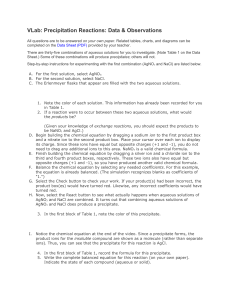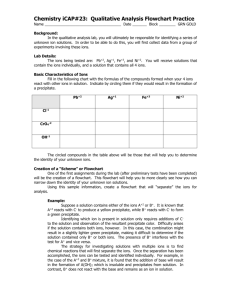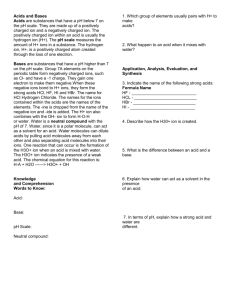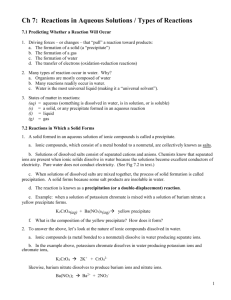File - Nicholas Vatteroni
advertisement
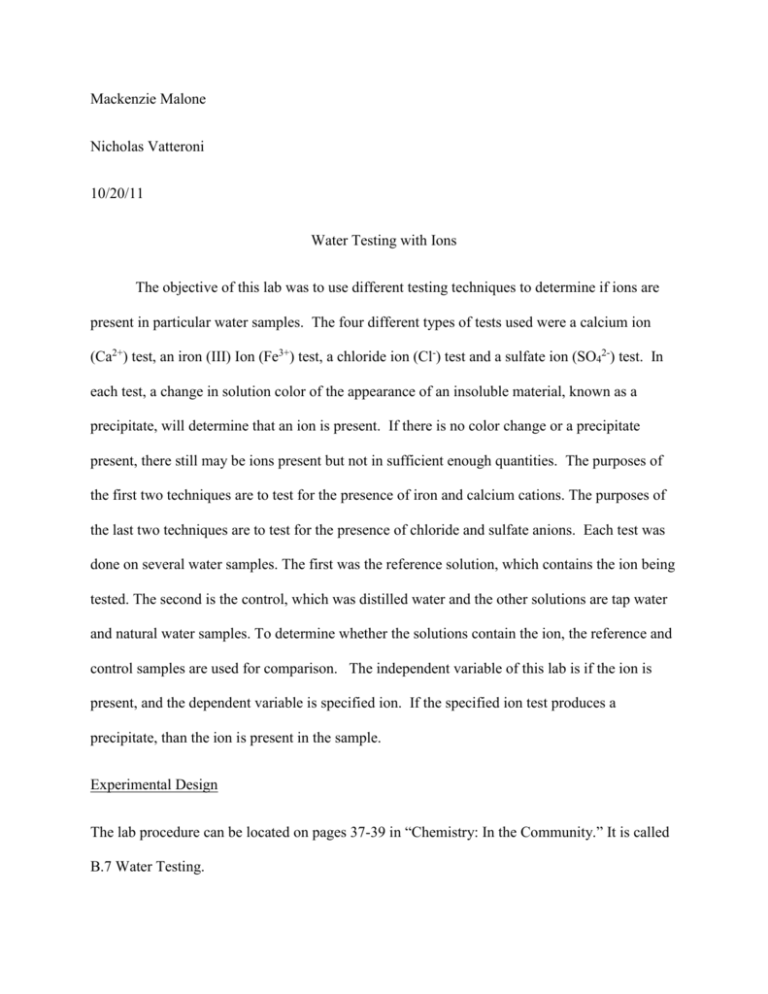
Mackenzie Malone Nicholas Vatteroni 10/20/11 Water Testing with Ions The objective of this lab was to use different testing techniques to determine if ions are present in particular water samples. The four different types of tests used were a calcium ion (Ca2+) test, an iron (III) Ion (Fe3+) test, a chloride ion (Cl-) test and a sulfate ion (SO42-) test. In each test, a change in solution color of the appearance of an insoluble material, known as a precipitate, will determine that an ion is present. If there is no color change or a precipitate present, there still may be ions present but not in sufficient enough quantities. The purposes of the first two techniques are to test for the presence of iron and calcium cations. The purposes of the last two techniques are to test for the presence of chloride and sulfate anions. Each test was done on several water samples. The first was the reference solution, which contains the ion being tested. The second is the control, which was distilled water and the other solutions are tap water and natural water samples. To determine whether the solutions contain the ion, the reference and control samples are used for comparison. The independent variable of this lab is if the ion is present, and the dependent variable is specified ion. If the specified ion test produces a precipitate, than the ion is present in the sample. Experimental Design The lab procedure can be located on pages 37-39 in “Chemistry: In the Community.” It is called B.7 Water Testing. Data Table: Calcium Ion (Ca2+ Test) SOLUTION OBSERVATIONS (color, precipitate, etc.) RESULT (is ion present?) Reference Precipitate, blue and grey Yes Control Precipitate Yes Tap Water No precipitate, clear Not enough ions to be shown Natural Water -#1 No precipitate, clear Not enough ions to be shown Natural Water -#2 No precipitate, clear Not enough ions to be shown Natural Water -#3 No Precipitate, clear Not enough ions to be shown Natural Water -#4 No precipitate, clear Not enough ions to be shown Data Table: Iron (III) Ion (Fe3+ Test) SOLUTION OBSERVATIONS (color, precipitate, etc.) RESULT (is ion present?) Reference Change in color, dark red Yes Control No precipitate clear Not enough ions to be shown Tap Water No Precipitate, clear Not enough ions to be shown Natural Water -#1 No precipitate, clear Not enough ions to be shown Natural Water -#2 No precipitate, clear Not enough ions to be shown Natural Water -#3 No precipitate, clear Not enough ions to be shown Natural Water -#4 No precipitate, clear Not enough ions to be shown Data Table: Ion (Cl- Test) SOLUTION OBSERVATIONS (color, precipitate, etc.) RESULT (is ion present?) Reference Completely white precipitate Yes Control White, precipitate Yes Tap Water Cloudy, precipitate Yes Natural Water -#1 Foggy, precipitate Yes Natural Water -#2 No precipitate Not enough ions to be shown Natural Water -#3 Barely cloudy, slight precipitate Yes Natural Water -#4 Fairly cloudy, precipitate Yes Data Table: Sulfate Ion (SO4 2- Test) SOLUTION OBSERVATIONS (color, precipitate, etc.) RESULT (is ion present?) Reference Precipitate, cloudy white Yes Control Barely cloudy Yes Tap Water No precipitate Not enough ions to be shown Natural Water -#1 No precipitate Not enough ions to be shown Natural Water -#2 No precipitate Not enough ions to be shown Natural Water -#3 No precipitate Not enough ions to be shown Natural Water -#4 No precipitate Not enough ions to be shown Conclusion: The hypothesis of this experiment did prove to be true because certain solutions did result in the ion being present. Any changes in color and the presence of a precipitate represents that an ion is present. As seen in the data tables of each specified ion test, the reference solution underwent a change in color and formed a precipitate. The control solution, which was distilled water, formed a precipitate from the calcium ion test, the chloride ion test, and the sulfate ion test. The control solution in the iron ion test did not result in significant enough amount of an ion presence to produce a precipitate. The calcium ion test, iron ion test and the sulfate ion test all did not produce enough presence of an ion to result in a precipitate. But the chloride ion test produced a somewhat cloudy and foggy precipitate for all of the solutions, except for the second natural water sample. Questions 1. a. A control was used in each test because it allows you to compare the test solutions with the reference, tap water and the natural water samples. b. Distilled water was chosen as the control because it is known that the sample wouldn’t contain the ion. 1. The difficulties associated with the use of qualitative tests are that the water samples can’t accurately be tested for containing ions because they will always contain ions but not in significant enough amounts. 2. These tests can not absolutely confirm the absence of an ion because like previously stated, the samples will always contain ions but not in large enough amounts to be registered. The only sample that wouldn’t contain any ions would be distilled. 3. Your observations could have changed if you had not thoroughly cleaned the wells or stirring rods between each test because there could be the chance of cross-contaminating the specified ions with the water samples.
